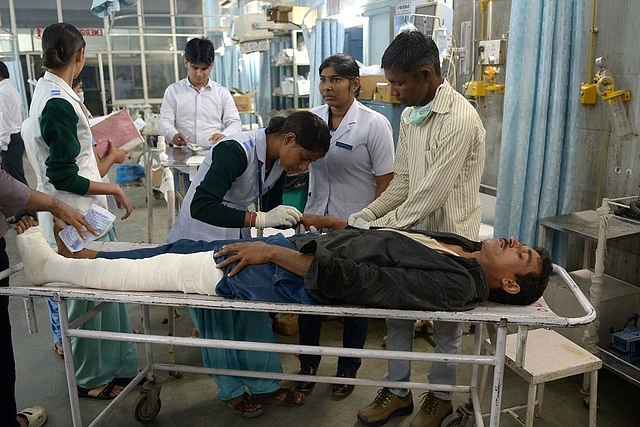
India Does Not Use Its Wealth For Health, And That’s A Cause For Concern
India’s public health expenditure is lower than even that of our smaller neighbours at just 1.02 per cent of GDP
As India increasingly focuses on holistic mental and physical health, our woeful public health spends should be a matter of concern. The good news is that per capita public expenditure on health has nearly tripled in nine years till 2017-18, but even then, India continues to remain one of the worst in terms of public health expenditure as a percentage of Gross Domestic Product (GDP). According to latest data from the National Health Profile 2018 (NHP), India spent only 1.02 per cent of its GDP as public expenditure on health in 2015-16, which increased to 1.28 per cent as per budget estimates of 2017-18, from 1.2 per cent in 2009-10. India’s spend is lower than even its much smaller neighbours.
Actual public expenditure on health almost tripled in nine years between 2009-10 and 2017-18, from Rs 72,536 crore to Rs 213,719.53 crore. But as a percentage of GDP, it only went from 1.12 per cent to 1.28 per cent when GDP itself expanded almost 2.5 times. Another worrisome statistic is: As per the BE (Budget Estimates) for 2017-18, the central government had the lowest share at 31 per cent in health expenditure last fiscal in all of the nine years under review, with states sharing the overwhelming burden of public health costs.
The data from NHP 2018, released earlier this week, also paint a bleak picture in terms of per capita health spending by India. They show that even when the cost of treatment has been on the rise in India and when this has led to inequity in access to healthcare services, we spent only 1.02 per cent of GDP in 2015-16 as public expenditure on health. The per capita public expenditure on health in nominal terms went up from Rs 621 in 2009-10 to Rs 1,112 in 2015-16. Or from one rupee 70 paise per person to just over Rs 3 per person per day.
It is important to remember in this context that the Prime Minister’s initiative of universal health coverage under Ayushman Bharat, which aims to offer a Rs 5 lakh cover at no cost to almost 40 per cent of India’s population, could have a significant impact in helping the poor get quality healthcare for free. The earlier Rashtriya Swasthya Bima Yojana (RSBY) is expected to collapse into Ayushman Bharat and the spend earmarked for the new scheme in its first year is Rs 10,000 crore.
But as things stand, India compares poorly even with its South East Asian peers in public health spending. The NPS data show in calendar 2015, India was beaten even by tiny Nepal (1.1 per cent of GDP versus 1 per cent in that calendar year for India) and others such as Bhutan (2.5 per cent), Thailand (2.9 per cent) and far outpaced by Maldives which spent a whopping 9.4 per cent of its GDP on public health. In 2015, India spent less than even low-income countries on public health, and just a fifth of what high-income countries spent.
In this context, the Ayushman Bharat scheme could be a game changer, provided it is implemented successfully. Remember, the total spend under RSBY was a mere Rs 467 crore in 2016-17, less than half the amount spent under the same scheme five years back at Rs 1,002 crore in 2012-13. The RSBY was a central scheme since 2007 designed to provide health insurance coverage for Below Poverty Line (BPL) families. Currently, there are 36,332,475 active smart cards across 29 states and Union Territories. Beneficiaries under RSBY are entitled to hospitalisation coverage up to Rs 30,000 for most diseases that require hospitalisation (this will increase to Rs 5 lakh per family under Ayushman Bharat).
In addition to RSBY, different states also run their own health coverage schemes. For example, Yeshaswini and Vajpayee Arogyasri schemes are state-sponsored schemes in Karnataka; Rajiv Arogyasri in Andhra Pradesh and Telangana; Chief Minister’s Comprehensive Health Insurance Scheme in Tamil Nadu and the Mukhyamantri Amrutam in Gujarat.
Another glaring marker of inequity seems to be in the wide variation in states’ indicators and spends on public health. Several states are well below even the pitiful national average of per capita public health spending. Bihar, a state which languishes at the bottom of the table in most health and development parameters, spent not even a rupee and fifty paise per person on public health in 2015-16 (Rs 491 per person in the year); Madhya Pradesh was a shade better, spending just about Rs 2 per person (Rs 716); third in the pecking order from the bottom was West Bengal which spent just over Rs 2 per person per day on public health (Rs 778 per person). Compare this with tiny Mizoram which spent the highest at Rs 5,862 or a little over Rs 16 every day on public health and it is clear that even some north eastern states are far more focussed on health than those at the bottom of the pyramid.
Mizoram spent more than five times the national average per capita. Arunachal Pradesh was next at Rs 5,177 while among Union Territories, Andaman and Nicobar was at the top with Rs 6,201 or almost Rs 17 a day.
It is further worth noting that Kerala continues to top vital health indicators, staying ahead on literacy, sex ratio, infant and maternal mortality rates. And Bihar, Jharkhand and Uttar Pradesh continue to lounge at the bottom of the pyramid as far as these vital health indicators are concerned.
To improve national health statistics, states which are lagging need to put in place much better monitoring systems besides also allocating a far bigger budget for healthcare.